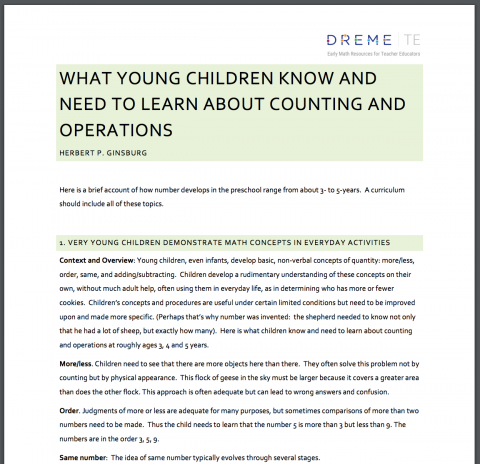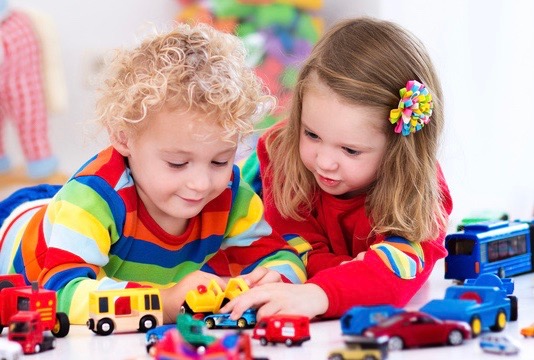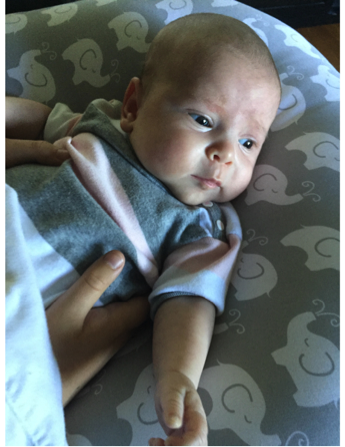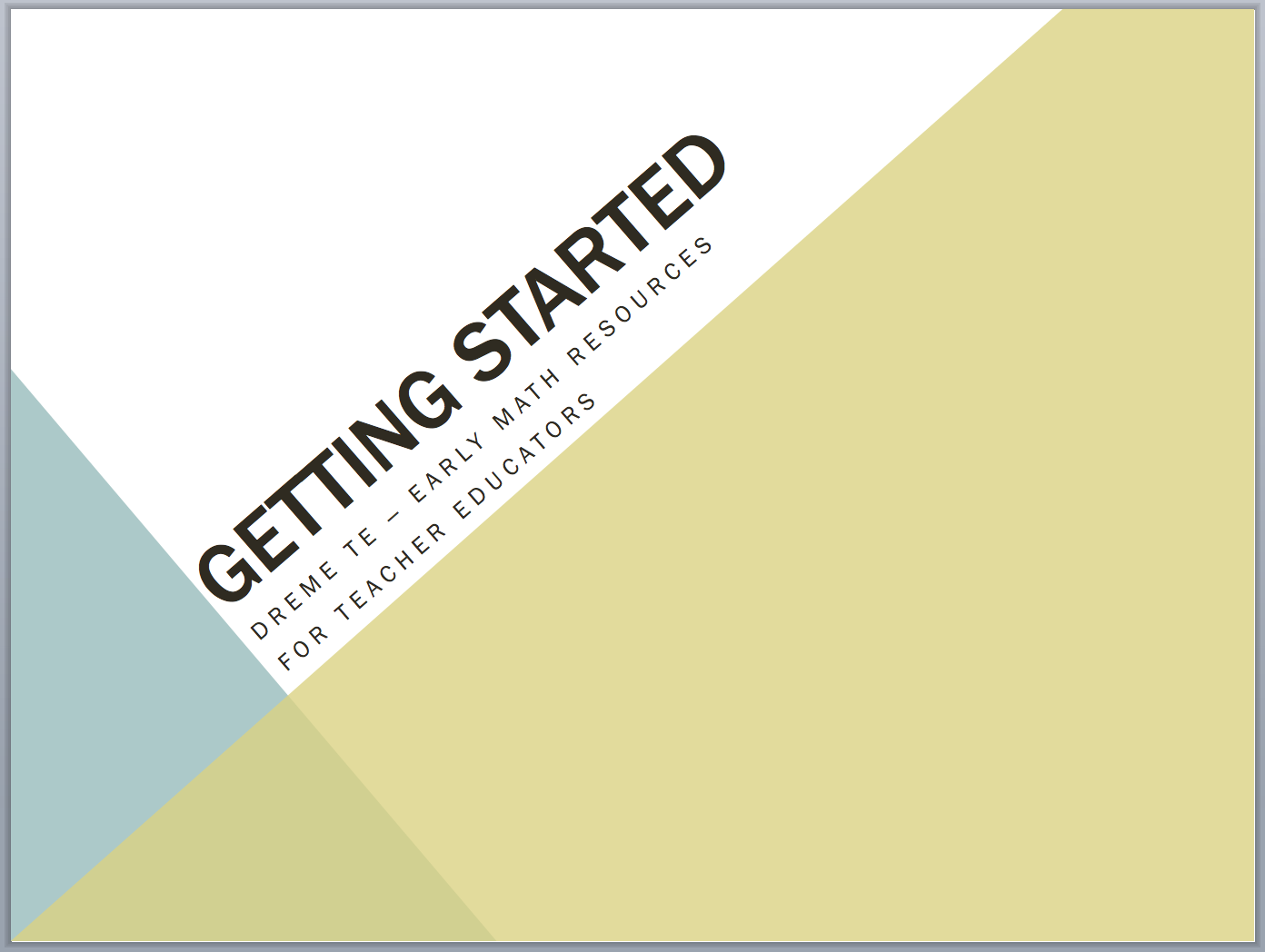Here is a brief account of how an understanding of the operations develops in the preschool years. Young children’s understanding of the operations develops out of their understanding of counting. For a complete account of what children need to learn about counting, see What Young Children Know and Need to Learn about Number.
Young Children Demonstrate Math Concepts in Everyday Activities
Context and Overview: Young children, even infants, develop basic, non-verbal concepts of quantity: more/less, order, same, and adding/subtracting. Children develop a rudimentary understanding of these concepts on their own, without much adult help, often using them in everyday life, as in determining who has more or fewer cookies. As young children develop understanding of counting they also learn about addition and subtraction.
Idea of adding as producing more and subtracting less. Children learn that that:
- When you add something to an existing set, the result is that you have more than you had at first.
- If you start with two groups of the same number, and by magic (while the child is not looking), one set is now more numerous than the other, you must have added to one or subtracted from the other.
- Children don’t have to count to arrive at these judgments concerning more and concerning addition and subtraction: they can solve the problem by reason alone.
Later instruction needs to build on all of these ideas when written numbers are introduced.
Everyday Numerical Addition and Subtraction
Context and Overview: The story now is how concepts of more/less, order, same, adding and subtracting without exact number (for example, adding means making a set larger without knowledge of the exact number), and enumeration get elaborated to create numerical addition and subtraction. Children learn some of this on their own, but adults can and should help.
Concepts to be learned to understand addition (subtraction is similar):
- Addition can be thought of in several ways, including:
- Combining two sets, for example, pushing together 5 crayons and 3 crayons to get a new group of 8 crayons
- Increasing the size of one set, for example, beginning with 5 crayons and then adding 1 crayon at a time until 3 crayons have been added and the new group has 8 crayons
- Moving forward on a number line, for example, moving 5 spaces on a number line and then 3 more to get to space 8
- Simple counting is also adding—1 at a time
- The order of addition makes no difference (the commutative property)
- Adding zero changes nothing
- Different combinations of numbers can yield the same sum
- Addition is the inverse of subtraction, for example, if taking away 5 from 8 yields 3, then adding 3 to 5 yields 8. This idea is crucial later on when children learn “fact families.”
Strategies used to add (or subtract):
Children often begin by using concrete objects and fingers to add but gradually learn mental calculation and remember some of the sums
- Using concrete objects, children may do the following to solve a simple problem like 3 + 2:
- Count all: I have 3 here and 2 there and now I push them together and count all to get 5.
- Count on from the smaller: I can start with 2 and then say, 3, 4, 5.
- Count on from the larger: I can start with 3 and then say, 4, 5.
- Approaching the problem mentally, children may solve the problem in these ways:
- Building on what is known (“derived facts”): I know that 2 and 2 is 4, so I just add 1 to get 5.
- Memory: I just know it!
More features of numerical addition and subtraction:
- It’s always useful to have backup strategies in case one doesn’t work: If unsure about memory, the child can always count to get the answer
- It’s important for the child to be able to check the answer
- The child needs to learn different strategies for different set sizes: counting one by one is good for adding small sets but tedious and inefficient for larger sets
- The child should also be able to describe how he got the answer: self-awareness is one aspect of “metacognition.” Of course, remembering what you just did is essential for describing it in words.
- Language is vital for describing one’s work and thinking and to convince others; children need to learn mathematical vocabulary
- The child should be able to apply the math in real situations or to stories about real situations (like word problems)
Groupings
Fair Shares. Young children are very much concerned with fairness. If you give Debbie one cookie, you had better give exactly one to her twin Becky as well. If you give two to Becky, you must also give two to Debbie. In this case, you are creating fair shares or groups—1 and 1, 2 and 2.
Suppose that Debbie and Becky have a birthday party and 8 friends attend. To ensure fairness (and keep the peace) the parent meticulously goes through the fair share routine of giving one grape at a time to each child until all the grapes are gone. The result is that each of the children (ten in all, including the twins) receives 10 grapes. In this case, the parent has (conveniently for our explanation of the math) created 10 groups of 10 each, so that there are 100 grapes altogether. The result is eminently fair and mathematically useful, for it provides the basis for several important ideas.
- The groups of 10 form the foundation of our counting system. There are ten tens and we can count them cumulatively as 10, 20, 30…100.
- The grouping creates the basis for division. In this case, the parent has divided 100 items into 10 groups of 10 each. Of course, if there were 30 grapes, the division would involve 3 grapes for each of the 10 children.
- The situation allows for multiplication as well: If we know that there are 5 groups, all the same number, with 4 in each, we can multiply to get 20 in all.
Of course we should not attempt to instruct young children in multiplication and division facts and algorithms. But we can engage them in counting by tens, employing one-one correspondence to create fair shares, determining the fairness of existing collections, and correcting unfairness when they see it.
Number Sense
Context and Overview: Children need to develop number sense, a concept that is notoriously difficult to define in a simple and exclusive way. I like to think of it as mathematical street smarts, which can be used in just about any area of number, including those discussed above. Number sense, which helps the child to make sense of the world, has several components, each of which undergoes a process of development.
Thinking instead of calculating. Number sense involves using basic ideas to avoid computational drudgery, as when the child knows that if you add 2 and 3 and get 5, you don’t have to calculate to get the answer to 3 and 2.
Use what is convenient. Number sense involves breaking numbers into convenient parts that make calculation easier, as when we mentally add 5 + 5 + 1 instead of 5 + 6.
Knowing what’s plausible or impossible. Number sense may involve a “feel” for numbers in the sense of knowing whether certain numbers are plausible answers to certain problems (if you are adding 2 and 3 you know that the answer must be higher than 3; anything lower is not only implausible but impossible).
Understanding relationships. Number sense involves intuitions about relationships among numbers—this is “way bigger” than that.
Fluency. Number sense involves fluency with numbers, as when the child knows immediately that 8 is bigger than 4 or sees that there are 3 animals without having to count.
Estimation. This involves figuring out the approximate number of a group of objects and is related to the notion of plausible answers.
The Transition to Written, Symbolic Math
Context and Overview: Formal, symbolic mathematics can provide students with more powerful tools and ideas than those provided through their informal everyday math. Formal math (and its use of symbols) developed in several cultures and is now virtually universal. Children need to learn it.
Everyday origins and formal math. Children encounter math symbols in everyday life: elevator numbers, bus numbers, television channels and street signs are among the many. Often parents, television, and software activities introduce some simple symbolic math—like reading the written numbers on the television or on play cards.
Schools certainly have to teach formal math. But doing so is not easy. Even though competent in everyday math, students may have trouble making sense of and connecting their informal knowledge to what is taught in school. Teachers often do not teach symbolism effectively. If children get off on the wrong symbolic foot, the result may be a nasty fall down the educational stairs. So the goal for teachers is to help children—even beginning in preschool—to understand why symbols are used, and to use them in a meaningful way—connecting already known informal mathematics to formal symbolic mathematics. The teacher needs to “mathematize” children’s everyday, personal math—that is, help them connect their informal system with the formal mathematics taught in school. It’s not ill-advised or developmentally inappropriate to introduce symbols to young children, if and only if the activity is motivating and meaningful. On the contrary, it is crucial for the teaching of symbols to begin early on, but again, if and only if it is done in a meaningful way.
Here are key issues surrounding the introduction of formal math to young children:
Young children have a hard time connecting numerals and the symbols of arithmetic (+ and -) to their own everyday math. They may add well but be confounded by the expression 3 + 2. It is as if the child is living in alternate realities: the everyday world and the “academic” (in the pejorative sense) world. The everyday world makes sense and the world of school does not. You think for yourself in the former and do what you are told in the latter.
The = sign is a daunting challenge. The teacher intends to teach = as “equivalent,” and thinks she has, but the child learns it as “makes” (e.g., 3 + 2 makes 5). This is a tale of how child egocentrism meets teacher egocentrism but neither talks with the other.
The solution. We should not avoid teaching symbols but need to introduce them in a meaningful way. This means taking account of what children already know and relating the introduction of symbols to that prior knowledge. It also means motivating the use of symbols. Thus if you want to tell a friend how many dolls you have at home, you need to have counted them with number words (symbols) and then use spoken words (“I have five dolls”), written words (“I have five dolls” written on a piece of paper or a computer screen), or written symbols (5) to communicate the result.
Manipulatives can help. Use of manipulatives can be effective in teaching symbolism and formal math. But they are often used badly. The goal is not to have the child play with concrete objects but to use these objects to help the child learn abstract ideas. The goal of manipulatives is to get to the point where children do not need them by putting them in the child’s head to use as needed in thought. For example, suppose the child learns to represent tens and ones with base ten blocks. Given the mental addition problem 13 plus 25, the child may understand that each number is composed of tens (the 10 by 10 squares) and some units (the individual blocks), and that solving the problem involves adding one ten and two more, which is easy, and then figuring out the number of units. The mental images of the tens and ones provide the basis for her calculation, part of which may be done by memory (one plus two is three) and part of which may be done by counting on her fingers (five fingers and three more give eight).
Conclusion
The basics of number are interesting and deep. Although young children develop a surprisingly competent everyday mathematics, they have lot to learn and teachers can help.
Download an expanded version of What Young Children Know and Need to Learn about Counting and Operations below




